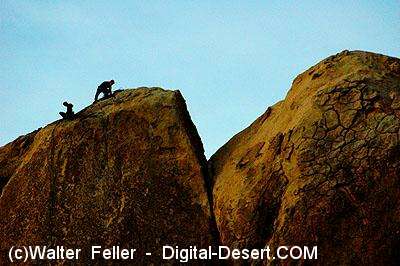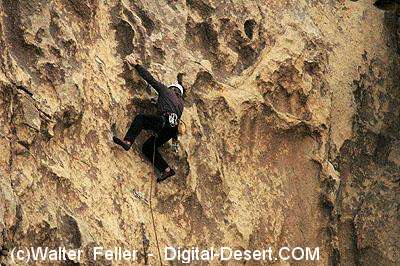Rock Climbing at Joshua Tree
The seemingly endless shapes and angles of Joshua Tree National Park's rock formations began capturing the imaginations of climbers over 50 years ago. Today Joshua Tree welcomes climbers and bouldering enthusiasts from around the world.This high desert monzogranite climbing mecca is famous for its traditional-style crack, slab, and steep-face climbing. Joshua Tree has more than 100 climbing formations and 8,000 climbing routes. With ratings from 5.0 to 5.14, Joshua Tree offers challenging climbs for levels of climbing ability. It is truly a world-class climbing destination.
If you are new to rock climbing and bouldering, please be sure that you are properly trained and equipped before you engage in these activities. You may wish to purchase a climbing guide or hiking map if you are unfamiliar with the park.
Tread Lightly
Fifty years ago, the impact of rock climbers at Joshua Tree was minimal, but today the park hosts hundreds of climbers and boulderers on a busy weekend. We must all do our part to protect this fragile desert environment, or it will cease to be a viable habitat for plants and animals, a valuable research area for scientists, and a welcoming place for climbers to enjoy. Treading lightly is everyone's responsibility.Etiquette
Be considerate -- ask permission if you wish to climb in a campsite that is occupied.Pack out your trash -- all of it: tape, chalk pieces, cigarette butts, micro-food articles and wrappers, and fruit peels and cores (they don't decompose in this arid environment). Please don't create a mess by dumping your trash into a pit toilet or leaving it next to a recycle bin. Pit toilets have to be pumped and filling them with trash makes the job difficult to say the least. Trash left outside dumpsters attracts ravens; the raven population multiplies, and ravens eat baby tortoises, and the desert tortoise is already on the edge of extinction. Leave your campsite and your climbing area cleaner than when you found it. Better yet, leave no trace!
Slack Lines
Slack lines may be attached to rocks, but not to vegetation. Slack lines are not permitted in campgrounds: picnic tables have been broken, Joshua trees have been toppled, and bulletin boards dislodged because of them. Slack lines and fixed lines may not be left unattended.Plants and Soils
Multiple approach paths (social trails) to the same cliff or boulder damage fragile desert plants and soils. Cryptobiotic soils that contain micro-organisms help to keep the sand in place and provide nutrients and moisture so plants can grow. When you walk on cryptobiotic soil, the micro-organisms die, so don't create a new path -- even if it is the shortest distance to your climb -- when a well-worn approach already exists. Walk on rock surfaces and in washes rather than trampling undistured soil.Use your crash pad carefully to prevent damage to plants near the base of climbs. Carry it rather than dragging it across the ground. Place it so that plants are not broken or crushed when a boulderer lands on it.
Don't be guilty of "large group sprawl." Limit the number of bodies around the boulder and you will limit the damage to the area surrounding the boulder. If several people are already bouldering in the same area of your choice, look for someplace better; you can name the new spot and add it to the list.
Cultural Artifacts
Joshua Tree has a rich cultural history and protects significant artifacts from historic and prehistoric American Indian groups. By law, archeological and historic sites and artifacts may not be disturbed. This includes rock art (pictographs and petroglyphs), habitation sites (rock shelters and camping sites), and cultural artifacts (pottery vessels and sherds, projectile points, stone tools, beads, etc.) While taknig a single piece (sherd) of broken pottery may not seem wrong, it could provide the clue an archeologist needs to accurately interpret the activities of American Indians in the area.Climbing within 50 feet of rock art is prohibited. Pictographs (paintings) and petroglyphs (carvings) are easily damaged and should not be touched. Skin oils, chalk, and boot rubber hasten the deterioration of these irreplaceable cultural artifacts. So does fire, never start a fire in a rock shelter.
Animals
In order to protect sensitive wildlife habitat, the entire Wonderland of Rocks is closed to overnight use. This allows the desert bighorn sheep to and other animals to visit water sources without being disturbed. Pets are banned from the backcountry. The presence of carnivores, such as domestic dogs, inhibits the feeding, travel and reproductive cycles of animals who must struggle to survive in the wild. Even leashed dogs cause extra stress on wild animals and are only allowed in campgrounds and within 100 feet of designated roads.Joshua Tree is home to about 250 bird species, including several birds of prey (raptors). Occasionally a climbing route will be closed during nesting season to protect these birds. Closure notices are posted in the area of the closure, at park visitor centers, at entrance stations, and at local climbing shops. If you encounter nesting raptors while climbing, please inform park staff and avoid the area.
Rock Formations
Chipping, scraping, gardening, comfortizing, and gluing holds is prohibited. Minimize the use of chalk and brush it off after sessions to minimize the visual impact.Closed to Climbing
Six areas of the park are closed to rock climbing due to their proximity to sensitive resources or private property. They include: "Energy Crisis" on the east side of "Little Hunk," the "Bonehead Wall," the "Boulder" at the base of Queen Mountain, and 50 feet of "Chicken Wing," "Heavy Metal," and "Hell Flake" in the "Indian Wave" boulder area. The private property across from Hemingway parking area is closed to climbing, as is Keys Ranch property. Visitors to the ranch must be accompanied by a park ranger; scheduled tours are available.Fixed Anchors
The rules that govern the placement of fixed anchors are complex. Please study them carefully as you are responsible for following them.A fixed anchor is defined as any piece of equipment that is left in place to facilitate a safe ascent or rappel. Examples include, but are not limited to, bolts, pitons, and slings. Only place fixed anchors as a last resort. Before placing fixed anchors on a route, think seriously about whether the route warrants them. Joshua Tree has a lot of top-rope routes, many of which are worth climbing, but not worth the bolting.
Fixed Anchor Specifications
The local climbing community suggests stainless steel hangers and bolts that are at least three-eights-inch in diameter and two and one-half inches in length. Please minimize visual impacts by camouflaging fixed anchors.Fixed Anchors in Non-Wilderness Areas
You are not required to have a permit to place new, or replace existing fixed anchors in non-wilderness. However, please consider the impacts of new fixed anchors on the quality of existing climbing routes, natural, historical, and archeological resources, and the experience of other visitors. A "fixed anchor checklist" was devised by the park, with advice from local climbers and other interested persons, to help you evaluate the potential impact of your proposed route. It is available at entrance stations and visitor centers.Fixed Anchors in Wilderness Areas
Fixed anchors may be replaced, anchor for anchor, in wilderness. A permit is required to place new fixed anchors in wilderness.Over 75 percent of the park is Congresionally-designated wilderness. Climbers are responsible for knowing where wilderness boundaries are located. A list of climbs and whether they are inside or outside of designated wilderness can be found here. If you are unsure about a particular location, contact a park ranger.
Fixed Anchor-Free Zones
Fixed anchors may not be placed in fiexed anchor-free zones. Additionally, the Barker Dam area, a popular destination for many park visitors, has been designated a fixed anchor-free zone to maintain its asthetic value for visitors. Fixed anchors may not be placed between the parking lot and the dam. If you wish t place fixed anchors in the surrounding area, make sure to identify the boundaries first.Power Drills
Power Drills may not be used without a permit. Power drills may not be used in wilderness.Climbing Safety
Rock climbing can be a dangeruos activity. The National Park Service does not maintain climbing routes or associated climbing gear and cannot guarantee your safety. You climb at your own risk.Most climbing in Joshua Tree National Park requires traditional climbing gear. Fixed anchors for top-roping are limited. Helmets are advised for all climbing activity in the park.
Hiking Trails




Rock Climbing and Bouldering Areas
Indian Cove
Quail Springs
Hidden Valley
Sheep Pass
Queen Valley
Split Rock
Belle/White Tank
Geology Tour
(W) = Wilderness